A BIG FOOTNOTE:
The main reason for this trip is to visit a little Cambodian village near Battambang. For our 40th wedding anniversary, we adopted a poor village in Cambodia. To celebrate our anniversary, we gave a big party and our generous, wonderful friends and family contributed over $4,000. Chanra, my U.S. friend who escaped Cambodia in the 80's, inspired the project. She has a sister (and family) still living in the Cambodian village-Prey Tauch. On her last trip to the village, she bought the village a $40 bicycle so the villagers would have a way to get around (to markets, to schools, to the clinic, etc.). Chanra's mother, Man Sowun (the absentee village matriarch), lives in San Diego with Chanra, but she returns often to the village to help her people.
Bill and I planned to go to the village a year ago (October 2006) and disburse the funds we collected for our anniversary, but Bill's prostate surgery changed all that. Instead, we sent $1,000 in cash with Man Sowun to take to the village and buy 10 bikes and basic essentials - rice, blankets, sarongs, etc. -- for the neediest families. She sewed pockets in her bra to stash the money away while traveling. She brought back pictures and video of the presentation of the bikes and goods and the huge village feast that followed. She contributed some of her own money and really got the most bang for our buck.
Now we're here in Cambodia to spend the remaining funds ($3,000) to buy a school shirt, a pair of flip flops, a pen, a spiral notebook, a sweet roll and a bottle of water for each of the 720 school children in the village. (Visit the Cambodian Village Fund website for more info). After we visit Angkor Wat, we'll travel to the Cambodian village and join Man Sowun to distribute the packages to the school children. We don't know quite what to expect. Chanra is scheduled to join us in the village.
A note about Man Sowun (Chanra's mother)
We first met Man Sowun about six months ago. We invited her and Chanra to dinner to decide when and how to spend the rest of the funds for the village. Man Sowun, in her Buddhist monk period, arrived in a white monk robe with her head shaved and claimed to speak no English. Chanra, her beautiful, sexy daughter, translated for her. Man Sowun was fasting so she didn't eat any dinner. We all sat on our living room floor and smiled a lot, interrupted only by Man Sowun's cell phone service reminding her it was time to pray. (Man Sowun is an early adopter and enjoys the latest in technology.) We wasted little time getting down to business. When we asked for suggestions as how to spend the money, Man Sowun pulled out a photo of her posing with what looked like an army of kids from the village, some shirtless, some dressed in rags. She pointed to their bare feet and said (through Chanra's translation) "We use the fund for the children - for their education - for the future." It was settled. Chanra finished her glass of wine and they left. At that time we didn't have enough money remaining in the kitty to cover the tab for the goods for 720 students, but thanks to generous contributions from friends and family, the fund grew to cover the cost. We would make Man Sowun's vision for the children (and the future) a reality and would see it all happen in a couple of days. |
Monday, Jan. 14 - Saigon to Siem Reap, Cambodia
Up early to do yoga, pack, have breakfast before our 9 o'clock taxi ride to the airport. (The shiny, new terminal was opened only a couple of months ago - nice, practical, but not like the classy one in Singapore.)
Our taxi driver was a friendly guy. He has a cousin living in Arizona. Almost all the Vietnamese we've met have a relative living somewhere in the U.S. The taxi driver told us that there are 3 million Vietnamese living outside the country and 1.4 million of them (about half) are in the U.S. He said he didn't have to fight in the war (in the South Vietnamese army) because he was the youngest of three brothers and could stay home and take care of his parents. His two older brothers fought, then when South Vietnam was unified with the North, they were sent to a "re-education camp" outside the city to be brainwashed. They were released after 2 years. U.S. policy granted entry to America for anyone who fought against the VC and was detained for 3 years or more in the re-education camps. His brothers were sad that they were retained for only 2 years and couldn't come to U.S.
We found the right lines at the airport and completed all the steps in the normal airline routine, then boarded the plane for a 45-minute flight to Siem Reap. We arrived at another brand new terminal - beautifully done. (Why can't San Diego get it together to build it's airport?) As usual, we faced the extra hassles when entering another country. We dashed around filling out forms, buying visas, clearing customs, etc. Finally, with all the proper pieces of paper stamped and in order, we were free. We found our Cambodian driver smiling and holding up a welcome sign with our names clearly displayed (a most welcoming sight) and off to the hotel we went.
We were blown away by the development in Siem Reap. Five years ago the road from the airport was way out in the country - now it's lined for miles with fancy, new, massive international hotels that remind me of the strip in Las Vegas. Our hotel, Lotus Angkor, is one of them. Wonderful large lobby, huge rooms, and beautifully decorated. We were greeted with a cool drink and sweet, smiling faces. We settled into our room and then went back to the bar for our daily beer fix. The bartender (Nlai) is a friendly 19-year old business student. One of his fellow employees is also a student studying English. We talked for an hour. They tried to teach us a few words in Cambodian and then laughed at my pronunciation.
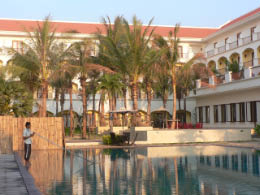
Lotus Angkor Hotel |
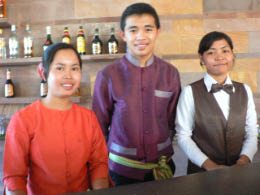
New pals at the hotel |
About 5:30 pm, we caught a tuk-tuk into town to have dinner at the FCC (Foreign Correspondence Club). Vin, our tuk-tuk driver, was also a friendly guy. It was great fun riding in the two seater behind his motorbike. We sat back and watched the wonderful, fun, strange sites of people passing by. There was a frightened calf, on his side, tied down in a cart attached to a speeding motorbike. I'd seen a lot of cargo packed on bikes and motorbikes, but never livestock.
The FCC is new (as is everything else in town) and fancy. We had eaten at the FCC in Phnon Phen in 2002 and still talk about that meal to this day. We were afraid our expectations were too high and we'd be disappointed - but boy were we wrong. We ordered the Khmer dinner for two and believe me, we'll be talking about this dinner for years. A tray came with a vegetable curry, a beef dish, duck rolls, spring rolls, calamari fried rice, amok fish along with four tasty spices. The flavors were heavenly. Of course we ordered dessert - a lime, coconut crème brulee to die for. We were giddy. I stopped by the kitchen to thank the cooks ("ocon" in Cambodian). They beamed and posed for a photo.
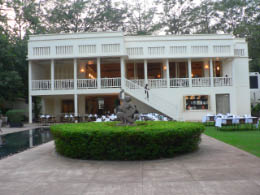
FCC |
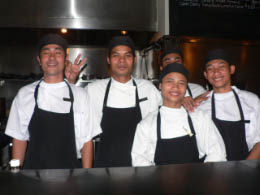
Killer Chefs |
Vin, the tuk-tuk driver, was waiting to take us back to the hotel. We drove through the once dusty little shantytown we had remembered back in 2002. A new city emerged overnight - a Mecca for upscale tourists with lots of fancy restaurants, shops and spas for serious pampering. I can't say I'm sad about all the development - that little shantytown was really the pits. Looks like Angkor Wat, with its new status as one of the 7 wonders of the modern world, is now the "in-place."
Tuesday, Jan. 15 - Angkor Wat
After breakfast, our guide (Sam) and driver (Wat) picked us up at the hotel and we were off to do the temple.
A Note About Sam, Our Guide
Sam is a fascinating guy - so passionate about everything and so much energy. He shared fascinating glimpses into his life. For someone just 35 years old, he's had some remarkable experiences. He rode in the ox cart (which he called their BMW) outside the temples with his grandfather. A poor and hungry kid, he begged in the streets with only 3 hours of sleep a night. His older sister didn't survive such a life. He played on an international champion soccer team in high school. He was a soldier at 14. (I'm assuming for the Khmer Rough. I didn't ask - he didn't tell.) With sadness he said he knows what it's like to carry a gun and kill and he doesn't want that for anyone. He said Pol Pot believed that the power is in the gun and that Cambodia should return to the agrarian economy of ancient Khmer times and destroy all modern developments - schools, hospitals, etc. Sam believes that power is not in guns, but in ideas and education. He went to school and became a lawyer (but refused to pay the government "corruption" fee required to practice law). He lives with his wife and two sons - a 9 year-old adopted son (a boy he rescued from the streets) and their 4-year old son. He works on causes for poor children - and is especially active in raising funds for the children's hospital.
Sam is hopeful for Cambodia's future and is working through the Sam Rainsy political party to rid the country of corruption. His friends called him the fat Cambodian man. He was a terrific guy, Jackie Chan lurking within. I loved his drama and his gift of storytelling. His brush with greatness was when he saw Angeline Jolie on set at Ankgor Wat filming "Tomb Raiders." He told her she was a beautiful woman and she smiled and said, "Thanks." It thrilled him. (Sam told us that we were "sweet" people (not like some of his "sour" customers). |
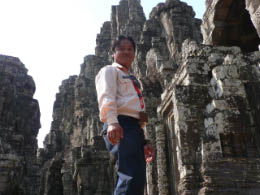
Sam, our main man in Angkor Wat |
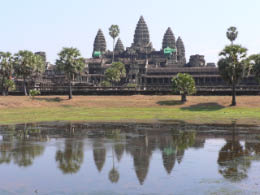
Ankgor Wat |
We passed through the Angkor Wat ticket booth. Man, has that changed! We remembered the the single little shack with a guard, which is now replaced by a high tech gate with a dozen or more turnstiles equipped with computers and high tech cameras to take your photo. We paid our $20 for a one-day pass, smiled for the camera, and received our tickets. (We paid $20 for a two-day pass five years ago.) For both temples we visited we went through what Sam called, "Check point Charlie." To enter, we had to present our ticket displaying our smiling faces before we could pass through. Tourism at Angkor Wat is big -- 5,000 people visit a day. Angkor Wat is #2 on the 7 wonders of the world. (Sam said his house is #3 - what a jokester.)
Angkor Wat
Angkor Wat was the first temple we visited that day - and oh, so impressive. The outer walls run about a mile long and a mile wide (to be precise, it's 1.5 km X 1.3 km for those who really care.) Sam gave us some background as we crossed the stone causeway and entered the outer wall of the massive temple. Here are some of the things we learned.
- Angkor (means sacred city) Wat (means temple) - It was built as a temple (or pagoda), not a city where people lived. The folks lived a ways down the road from the temple in a place called Angkor Thom (where we visited later).
- Soryavarman II was the emperor who built Angkor Wat.
- It took 37 years to build (1116 -1145) -- Can't imagine the architect that came up with plans (without computer-aided design), then went through the approval and sign off process, then the contractor, the subs and slaves pulled it off.
- Angkor Wat is the largest religious monument in the world.
- The temple is guarded by stone lions (for power) and by the 7-headed long serpents (Naga adapted from the Hindu and merged into Buddhism.) The lions and serpents had bulging, goggling eyes, along with a lot of other ancient creatures with those same bulging eyes.
- The temple faces the west - most Khmer temples are oriented to the east. Therefore, it's believed the temple, dedicated to Vishnu (the god associated with death) was a funeral temple. A huge effort and resources went into constructing a place to stash a few king's ashes.
- Two impressive libraries flanked the main thoroughfare on the temple grounds. The poor scholars climbed a couple of flights of very narrow high steps to get to their books (or stone tablets).
- The five main towers at the temple center are depicted on the Cambodian flag.
- Ancient statutes were once everywhere. Most are gone and several Buddha statues were head-less. The treasures were taken by vandals or corrupt government officials or by the poor to buy food.
After we crossed the moat, we entered the gallery area - four long hallways arranged in a square, each side about the length of a football field. (The hallways surrounded the center of the temple.) On one side of each hallway were arch windows carved in stone, letting light filter in on the massive bas-reliefs carved on the opposite wall. The bas-reliefs were a marvel, carved on large individual blocks and seamlessly fit together. The carvings gave an insight into life in the 11 th / 12 th centuries and depicted Hindu and Buddha myths. The purpose of these intricate stone carvings, much like the Christian murals and frescos decorating the walls of old cathedrals, was to teach the locals (who could not read) the stories of their gods and goddesses and history of their people.
Sam walked us down the long corridors, each section portraying a different legend. He explained the tales in the stone details. Without him, we would have been clueless. We saw endless battle scenes, royal processions, marching soldiers, leaders carried on the backs of elephants, generals on horses and ancient boats floating down the river to name a few. My favorite mythical stories were:
- The Battle of Lanka -- Rama and his monkey-pals defeated the well armed enemy soldiers. The monkeys (the good guys) won without weapons because they used their teeth. There were some great scenes of monkeys ripping into the flesh of the soldiers.
- Churning of the sea of milk - Naga (the multi-headed serpent) was the star in this one. A long line of men (demons and good guys), half facing one way, half facing the other, were in a tug of war with Naga being used as the rope. Legend has it that pulling Naga back and forth churns up the ocean of milk - the nectar of life. The churning causes people on earth to fall into hell and then be recycled into heaven and earth again. (Don't quote me on this one.)
- Heaven and Hell - This mural was meant to scare the hell out of the people. The top section represents floaty, happy people in heaven, the middle section represents life on earth and the bottom section represents people in hell. The hell scenes were hellish with such torments as guys roasted on a skewer, tongues pulled out, spears through the eyes.
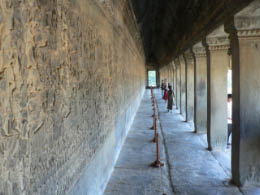
Long hallways of bas reliefs |
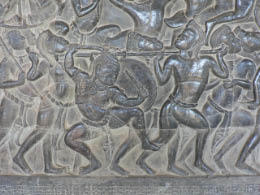
A tiny part of the huge bas reliefs |
After the bas-reliefs, we entered the section lined with a maze of meditation rooms with a Buddha in each room surrounded by rising smoke from incense sticks. We explored the series of cubic rooms and then passed to the inner sanctum of the temple. The five towers at the temple center are designed to look like lotus flowers. Sadly, in the 1990's, ill-informed archeologists from India tried to clean the towers by using ammonia, but ended up causing massive damage and leaving behind a couple of crumbling piles. We were not able to climb up to those towers because a Korean fell off one last year and filed a complaint. (Sam seems annoyed with Korean tourists.)
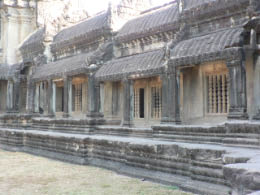
Angkor Wat |
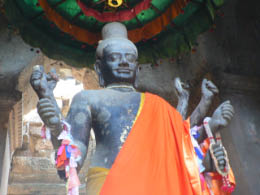
Buddha in one of the meditation rooms |
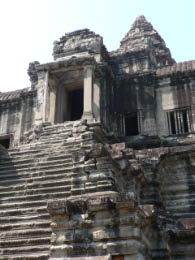
No climbing allowed |
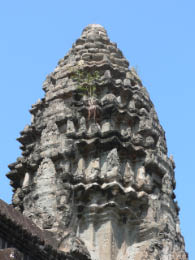
Tower designed like a Lotus flower |
Hundreds of beautiful, alluring dancers were carved on the wall - honoring sexy women and Apsara, the dancer goddess. She's depicted with her feet in profile, while her body faces forward - only a goddess could do that. The carvings depicted graceful hands, posed in different positions, to demonstrate the phases of life -- planting, growing, blooming, producing fruit, then dieing.
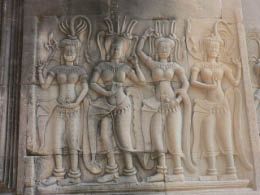
Apsara, the dancer godess |
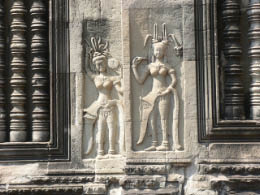
Dancers everywhere |
We spent about three hours exploring Angkor Wat and taking lots of pictures. Next stop was lunch - simple little chicken / veggie stir fry along with some beer at one of several cafés lined up next to the parking lot. (I'm sure Sam is buddies with the owner.)
Angkor Thom
After lunch, we visited Angkor Thom (meaning great city). Built around the 11 th century, it was one of the largest of the ancient Khmer cities with a population of one million. A wall (like the great wall of China) surrounded the city. The royalty, leaders, generals and their families (and concubines) lived inside the wall while the towns folk lived outside, down by the riverside. During an invasion, the commoners came inside the wall for protection.
The most amazing sights are the huge stone carvings on the road on the bridge just outside the city's southern gate. The road is flanked by massive figures - on one side the figures are smiling, on the other side, they are frowning. Both sides are holding the great long serpent (Naga) from the churning of the ocean of milk fame. Inside the gate are a couple of three-headed elephants carrying some gods. (Somebody must have been doing a lot of dope back then.)
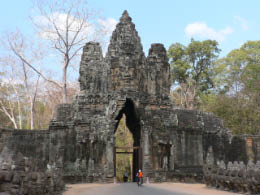
Angkor Thom's southern gate |
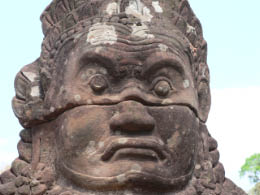 Head shot
|
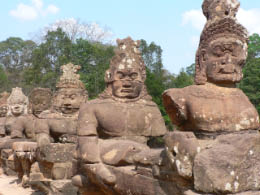
The Bad Guys holding Naga |
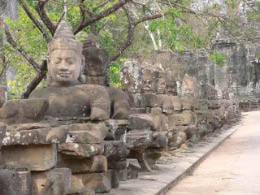
The Good Guys holding Naga |
Beyond the elephant gate, we drove through a forest of teak and Mahoney trees on our way to the main temple in Angkor Thom - Bayon. Bayon was on a much smaller scale than the temple at Angkor Wat, but we liked it better. The bas-reliefs depicted scenes from everyday life - marketplace, restaurants, turtle biting a guy's butt, rats running up a tree to steal a coconut, women barbequing fish on a stick, etc. After being charmed by such creativity, we entered a narrow stairway to the central sanctuary where giant stone faces smiled down at us from every angle. We snapped photos like crazy - just couldn't get enough.
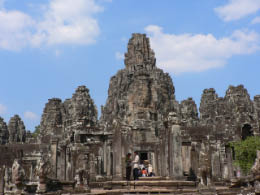
Bayon temple at Angkor Thom |
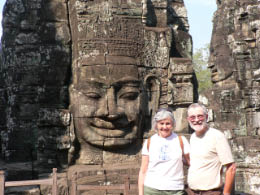 Faces smiling down on us
|
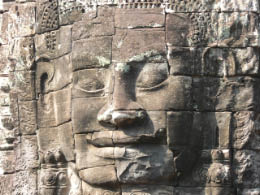
Happy Face |
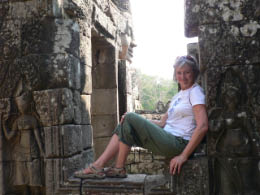
Another happy face |
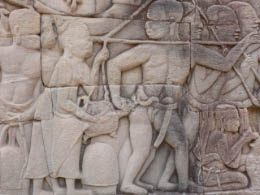
Turtle biting a guy's behind |
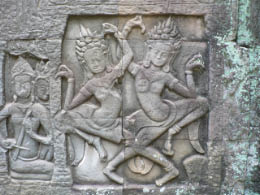
More dancers |
On our way home we stopped at Artisans d'Angkor -- a vocational center for kids ages 18-23. A graduate of the program led us through the different workshops - stone sculpture, woodcarving, and painting. It was hot and we were wilted and weren't up to another tour - but we were "sweet" troopers. We watched a room full of young girls, all artists, all hearing and speech impaired, and all busy doing their artwork. We were glad when the tour was over. We bought a few things in the gift shop and then were on our way back to the hotel.
We changed rooms at the hotel. (We could hear the noisy Koreans partying at the bar the night before. We settled in our new room. Bill did the wash while I pounded out the journal. We walked to Madame Butterfly just down the road for dinner. (The walk was not pleasant, along a dusty, busy road with all manner of transportation buzzing by.) Madame Butterfly was charming and in a wonderful old colonial house. We sat in comfy rattan chairs, surrounded by antiques, with large fans whirling overhead. However, the food didn't compare to the Foreign Correspondence's Club.
Back at the hotel, we called the contact cell phone number for Chanra at the village. Man Sowun answered the phone and spoke in broken English. Man Sowun said that Chanra is traveling with her younger brother and sister and would meet us in Siem Reap.
Wednesday, Jan. 16 - Museum Day in Siem Reap
Up early for a little morning yoga, then breakfast with our smiling Cambodian friends. Nlai, the bartender we met yesterday, adopted us. He sent Bill an email. The note didn't say much, only that he was excited because it was the first email he ever sent. (Bill has a new pen pal.)
After breakfast we got a tuk-tuk to the brand spanking new Angkor National Museum. It just opened two months ago (November 12, 2007) and wasn't mentioned in any of the guidebooks. (Sam, our Angkor Wat guide, told us about it.) We got there at 8:30, 30-minutes before opening (bad information from the hotel), so we walked to the Tourist Information Center, half a block away and got a good map, along with some recommendations of what to do today.
We got back to the museum at 9 just as the doors were opening. Oh WOW, we were lucky to get to see the place. What classy displays, great videos, and just the right amount of relics (not to overwhelm you). Best yet, the tour groups haven't added it to their programs yet so we had the place all to ourselves. What a treat!
Ohmigod was all that we could say when we entered the gallery named "Room of 1,000 Buddhas." About 950 of the 1,000 Buddhas were small relics (6 - 12 inches), each sitting in it's own well-lit alcove stacked floor to ceiling like honey combs. The big Buddhas posed center stage. A smiling museum guide wanted to tell me what all the different hand positions of the Buddhas meant - peace, blessing the earth and on and on. She, along with all the other museum employees, were so happy to share such a wonderful place with us.
We learned about the Pre-Angkor period, the Khmer civilization (how it was settled), and some of their religions and beliefs. The early religion used phallic symbols for fertility. They were part of a fountain and the water running over them became holy water, great for cleansing.
Hindu religion dominated the pre-Angkor period. Naga (the 7-headed serpent) started out as Hindu. Naga reared its ugly head everywhere and was the most powerful animal god because it lived on water and on earth and carried souls to heaven (or something like that). We saw remains of Naga's (with their bulging eyes) all over Ankgor Wat yesterday. Naga later morphed into the Buddhist religion and wrapped itself around a heck of a lot of Buddha statues (Buddha is often depicted sitting on the coiled up Naga, with Naga's head behind Buddha).
We learned a little about the Khmer kings and empires. Just like the Greeks, Romans, Mayans, and other great civilizations, the Khmer movers and shakers built grand temples to their gods. Now we have the ancient ruins to ponder why. There were four great Khmer Kings:
1. Jayavarman II (802-850) - whose claim to fame was uniting two kingdoms
2. Yasovarman decided that the Khmer capital would be located at Angkor
3. Soryavarman II built Angkor Wat - not an easy task, especially given the fact that it only took around 37 years to build (1116-1145)
4. Jayavamen VII (my personal favorite) built Angkor Thom (1181-1201). He was a humanitarian and built many hospitals. He also constructed roads for travels and established a system of rest-houses along the way. He had a couple of very caring wives - one was concerned about the poor people. She died and then he married her older sister who was very clever and the top professor at a university.
The two main rooms downstairs contain facts and ancient relics from Angkor Wat and Angkor Thom. It was especially meaningful to us because we had just visited there the day before.
Angkor Wat and Angkor Thom were probably designed by somebody from outer space. (Hope you know I'm kidding - but the places are truly engineering miracles.) We strolled through the exhibits, trying to take it all in. (The audio guide, which would have helped, isn't ready yet.) We passed by the stones carved in the Khmer ancient language that nobody knows these days. We saw an exhibit on ancient styles - the latest fashion in folds in loin cloths (designs taken from fish tails), hair styles, jewelry, hats, etc. I liked the exhibits about Apsara, the ancient dancers - so alluring, so graceful and exotic. They had to have double jointed fingers to do those hand movements. Angkor Wat was covered with these beautiful dancing ladies.
The last room at the museum was the gift shop, of course. Even Bill, the big non-shopper, found it a pleasure just strolling through it. Of course there were more smiling, friendly employees wanting to practice their English and wanting to come to California. We couldn't really shop because it would be rude to ignore the salesgirls' friendly small talk. (They need a lesson in capitalism.)
After the museum, we walked along the dusty roads to the temple, Wat Preah ang Kau Sey, recommended by the Tourist Office. The place was closed for lunch, so we chatted briefly with a monk.
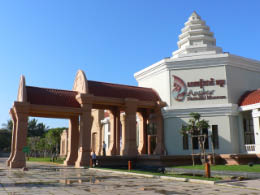
The all new Angkor National Museum |
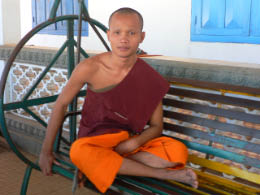
Monk relaxing at the Wat Preah ang Kau Sey |
We hired a tuk-tuk to take us for lunch at the Khymer Kitchen (in the center of town right across the street from the Old Market). One dish we ordered was great (Chicken curry with veggies); the other one was not very good (Beef with Noodles). We washed it down with Angkor beer. (We switched from Tiger because of our rule of traveling - it's best to order the local brew.). We headed off to the market across the street. Unlike Vietnam, the Cambodian salespeople are gentle and non-aggressive so we brought a few things in peace.
We hired "Mr. Rock" (for Rock Star) and his "Rolls Royce" tuk-tuk to take us back to the hotel. Mr. Rock was a fun character.
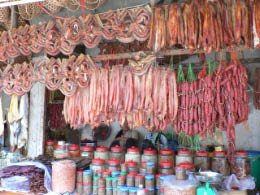
The Old Market in downtown Siem Reap |
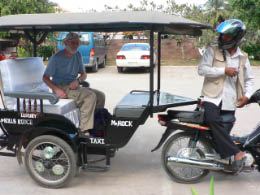
Bill with Mr. Rock |
By the time we got to the room, I was having a bad tummy ache (probably from the Kymer Kitchen) - hope it's just gas. We relaxed a little, then checked emails. Nice to hear from Amy.
We called Man Sowun, Chanra's mother. She told us Chanra was on her way to Siem Reap to meet us and should be there within the hour. We were excited about seeing Chanra. However, after another couple of hours and no Chanra, we called Man Sowun back. We were surprised when Chanra answered the phone and informed us the she had changed her plans and had booked an early flight back to the U.S. She had to get out of Cambodia. She had gone with her brother and sister to Phnom Penh and visited the Tuol Sleng 21 Genocide Museum - the school where the Khmer Rouge set up shop to murder and torture the people (only one person got out alive). Bill and I visited there five years ago and were horror stricken, but Chanra, having lived through it and witnessed torture and killing firsthand, found it impossible to stay in Cambodia another day after her visit. I talked to Chanra and she told me about her uncle's torture and death. The visit to the school stirred up those horrible memories again. We were so sad for her and the terrible pain that she carries. We will miss her at the village.
We had a late dinner at the hotel - a little Pad Thai hit the spot. We arranged for the boat to Battambang early tomorrow morning and tried to get some rest.
Thursday, Jan. 17 - Boat Ride from Siem Reap to Battambang
Up at 5 to do yoga - then went to the lobby at 6, the assigned time for the van to take us to the boat dock. The boat was scheduled to leave at 7 and it's a 30-minute drive to the the dock. At 6:30 we were pacing the lobby floor wondering if we'd make it. Finally, at 6:50, a van packed with big Westerners and their big luggage, arrived. Luckily, they put us in the front seat. We thought we were the last ones on the van. Wrong, two more stops and 4 more big customers and big luggage squeezed into the van before we were off.
We remembered the empty road out in the country to the boat dock back in 2002 and the bridge that had collapsed. Now the bridge is strong, and the country road is lined with houses made of bamboo leaning into each other for support. Last time I remember the hordes of people coming up from the riverbed early in the morning. At least now, they now seem to have a little shelter.
The van stopped and life suddenly got very hectic. I was trying to collect our bags tied to the top of the van while Bill was trying to find the van driver to get our tickets. A couple of strong locals grabbed the bags (for a fee, of course) and I directed them to a big boat that was filling with people. Lucky for me, Bill was paying attention and yelled at me, "That's not our boat." I followed him to a little boat (capacity about 30) and climbed on. (It's not good to make assumptions about traveling. Silly me couldn't imagine going all that way in that tiny boat!)
Since we were about the last to board, we were at the front. I thought that was a good thing (another bad assumption) until that little boat, nestled deep into the water, took off full force across a Tonle Sap lake. Water on both sides poured into the boat, drenching us. The spray, along with the morning chill, made for an unpleasant ride. The passengers seated farther back didn't get the flooding. I spotted a matt tucked away in the hull of the boat and built a little fort for us for protection. We got to know a sweet Swiss couple who huddled with us during the hour-long battle with the waves lapping over us. She's a pre-school teacher and he's a birder. They have been traveling since October. We were soaked - our backpacks were soaked. We thought we'd have to endure this water torture for the entire five-hour boat ride, but happily, our driver turned up a river and the waves settled down.
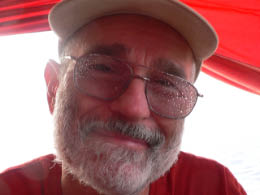
Drenched from the boat ride |
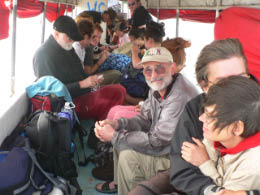
Packed into our little boat |
The "3 to 5 hour" boat ride turned out to be almost 7 hours - never boring, but our legs started to go numb around hour 6. We passed by floating villages and river banks lined with houses on stilts. When there was no sign of civilization, the wonderful birds took over - so many egrets soaring overhead and dark duck-like birds skimming gracefully over the top of the river. There were also lots of small florescent birds doing aerial acrobatics. I don't know what they were, but our new Swiss birding friend got very excited. (This area is a hot spot to watch birds.)
I enjoyed watching the people go about their day-to-day life. There were lots of little kids swimming at the river's edge without swimsuits and without supervision. Families floated lazily by in their houseboats. Women seemed the busiest. I saw them on shore sorting piles of silver fish, or mending fish nets, or whacking plants with their machetes, or washing clothes in the river, or bathing babies, but always smiling, waving, going on with life. (Men were more reluctant to wave or even acknowledge our goggling.) I was on sensory overload and couldn't control my shutter finger.
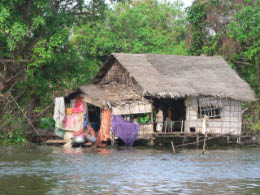
Home sweet home |
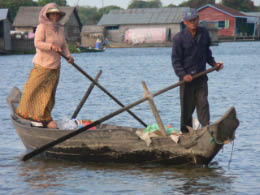 Life on the River
|
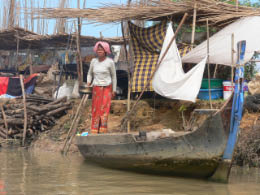
Life on the River |
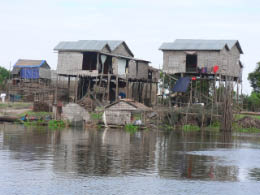
Houses on stilts |
We made a quick rest stop at a falling down wooden building floating right in the middle of a floating town. I followed the signs to the WC (A.K.A. bathroom) and waited in line. The stall was nothing more than an outhouse floating over the water. I found a hole directly over the water - no need for waste sanitation here.
Bill and I shared a coke while a couple of little village girls about Zi's age rowed an old dugout canoe right up to the crowds to beg. We gave them the bananas packed in our breakfast box from the hotel. It's tough to see the poverty. By accident of birth, these beautiful little girls were there holding out their hands to us oversized Westerners.
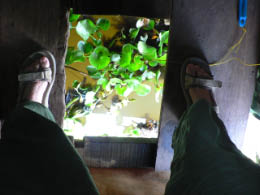
View from the toilet seat |
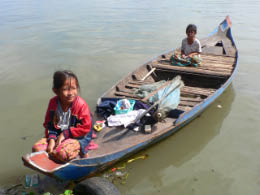
Beautiful little beggar girls in an unfair world |
The hot sun came out and chased away the chilly morning. Time for sunscreen and to watch more amazing sights as we motored by. I was fascinated by the large fishing nets attached to bamboo poles. I was also fascinated by the variety of boats. Along with the fishing boats, the houseboats, the taxi boats, there were large cargo boats carrying all sorts of construction materials. Everyone seemed busy, except the children who just wanted to wave and say, "Hi."
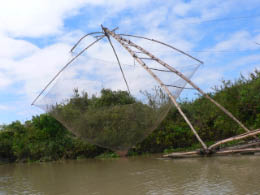
Huge fishing nets |
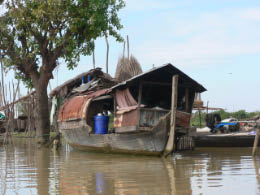
Lots of houseboats |
About an hour before we docked, the boat's first mate, standing on the front of the boat with a large pole, helped guide the captain through the shallow areas. It was dry season and the river was low. We heard the boat bottom scrape along underwater trees. We had to duck to avoid the branches hitting us in the face. It was slow going , but we finally made it to the boat dock in Battambang. I was most frightened when we disembarked. I was carrying my backpack while climbing up steep metal, narrow stairs with no handrail that seemed to climb to the heavens. I didn't dare look down between the narrow bars, or fear would settled in and it would be all over. At the top, a couple of local guys returned to the boat to retrieve our luggage (for a fee, of course). In no time, we hired a tuk-tuk, stuffed the luggage in and headed for our hotel.
Bill found a great little 7-room hotel, La Villa, on the Internet. In 2003, the hotel owners (a Vietnamese woman, born and raised in Paris and her French husband) bought a mansion built in the 1920's. They completed a 9-month renovation and turned it into a charming, classy place that maintains the original character. Our room is in the penthouse - more stairs to climb loaded down with bags - but well worth it. The house was built by a wealthy Chinese merchant and stayed in his family until the 1970's when Cambodia was turned upside by Pol Pot and his hoodlums. It was then given to a Khmer General. Lien, the owner, told us that she and her husband fell in love with the house when they saw it. It was not even up for sale, but within a month, they purchased it from the General's heirs.
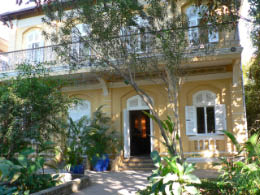
La Villa |
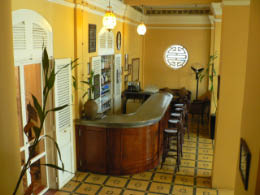
The Bar at La Villa |
We unpacked, charged up the camera batteries and then went down to have a beer (Angkor Beer) and quiche Lorraine in the peaceful, quiet courtyard shaded by tall graceful trees. We're happy to be here (and off that boat)!
We finally got in touch with Man Sowan. Unfortunately, she came into town (Battambang) today, but our boat was late, so we missed connections. She said they will pick us up at 8 in the morning to take us to the village for the festivities.
Bill got the latest trip report out on our website, then did the laundry while I tried to catch up with the journal. At 7, we went back downstairs to have dinner at the hotel. We had grilled salmon.
The temple next door is shooting off firecrackers in honor of some kind of new year's celebration. The loud bangs sound like guns and stimulate my over-active imagination of Khmer Rough hiding in the trees outside. We tried to get some sleep - tomorrow's the big day when we visit our village.
Friday, Jan. 18 - Visit to the village
Had a lovely breakfast in the hotel atrium. At 8 o'clock, Man Sowun, her daughter Mao (who lives in the village) and the young, hip driver who had that James Dean "rebel without a cause" look picked us up at the hotel. Man Sowun said the driver was her adopted grandson. (She had a big family and manages to adopt a lot of others along the way.)
We had a full day ahead of us, full of surprises in store. The first surprise was what happened to Man Sowun, that shy little Buddhist monk who sat quietly on my living floor communicating by pointed to pictures. Man Sowun, dressed in a white silk blouse with gold buttons with tan slacks, was in charge. She was charismatic, powerful and made Oprah look like a wallflower. It felt good just to be in her presence.
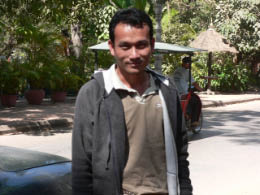
Our James Dean Driver |
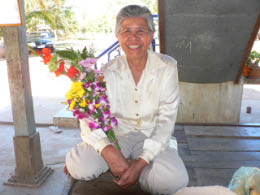
Man Sowun, our leader |
Our first stop was at the open air market in the center of Battambang. Man Sowun and Mao went into action - negotiating, buying beef, vegetables and other food. I watched Man Sowun's direct, yet graceful moves through the market. She was on a mission. I stood dazed and confused while both Man Sowun and Mao completed a series of quick transactions. The next stop was at the bakery to pick up loaves of bread. Last stop was to pick up a couple of cases of beer and water before we headed to the village, 30 minutes away.
We had no idea what we were in for. The car pulled up along a dusty road and there they were 720 cheering school kids lined up along both sides of the road leading to the school. Bill and I were overcome with emotion and weak kneed as we got out of the car. The school's headmaster, teachers and town dignitaries greeted us, put orchid leis around our necks and handed Man Sowun a boutique of flowers. Then we walked through 100 yards of excited, beautiful kids, lined up along the road, in a range of sizes all dressed in their worn old school uniforms. Some were jumping up and down and whistling. All were clapping and excited to see us. We were blown away. Nothing has ever touched me so deeply. The little money we gathered and contributed seemed insignificant to us, but to those poor kids a world away it brought the greatest joy. Tears flowed as we walked through the line. Even Bill choked up. We walked with Man Sowun in her regal gait oozing charisma. I had never been a dignitary on such a grand scale and wasn't sure what to do or how to act. (I wondered how Princess Di would handle this.)
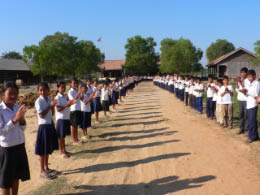
720 school children line the road cheering for us |
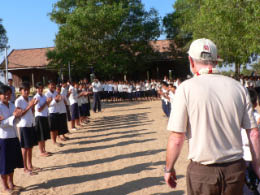
The amazing walk down the kid-lined road |
We walked into the main village area and were seated on an open veranda with Man Sowun, the school principal and other assorted village leaders. We each had a bottle of water, but quickly we were given larger bottles.
I did some deep breathing to try and settle down. I was still in shock from the warm welcome and grand entrance. Just below the veranda was a series of 5 or 6 long wooden tables piled high with the gift packages (school shirt, flip-flops, pen, and a spiral notebook), all sorted according to size and gender. The tables of gifts and the veranda separated us from the kids. I tried to peer around the tables to see the kids with their dark eyes, dark hair and faces beaming with smiles.
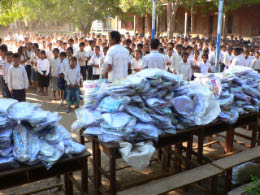
Tables piled high with gift packages |
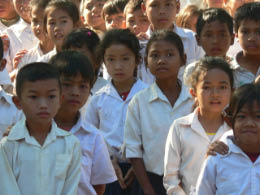
A sea of beautiful little faces |
In no time they formed long lines according to size and gender. They squatted down in the dust to listen to speeches which seemed to go on and on. I wish I knew what the village leaders were saying. We heard the occasional Mr. Bill and Miss Nancy which made us chuckle. Bill and I were asked to say a few words. I called on my Toastmaster training, then remembered nobody, except for Man Sowun and Bill, knew what I was saying.
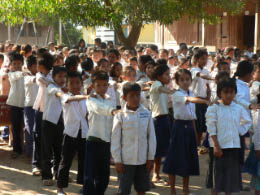
Lines of children |
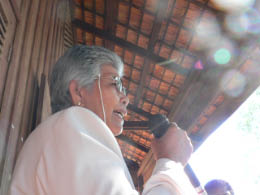
Man Sowun giving a speech |
As the speeches continued, I thought how this all came and marveled how a simple idea -- 40 years of marriage / $40 bicycle took on a life of it's own -- thanks to our generous family and friends and to Man Sowun and her family. Now we were here witnessing this miracle. I wish I could bottle the appreciation and love and gratitude we were feeling and take it back to share with all those who made it happened. Oops, I'm getting sidetracked - It was a powerful moment.
When the speeches were over and the clapping done, Bill and I handed a package to each child. Man Sowun and a group followed behind us passing out sweet rolls and a bottle of water. It was well organized. Guys would appear out of nowhere carrying piles of packages - right size, right gender - for the particular line of kids. I moved right down the line placing a package in the hand of each grateful kid. Each child would say something, then put their hands in prayer position and do a little bow. It was such a joy seeing each little face. From my former life as a teacher, I got a sense of each student - the goody-two shoes, the nerd, the class clown, the serious student, class leader and so on. It was the greatest joy for me to make a little connection with each kid.
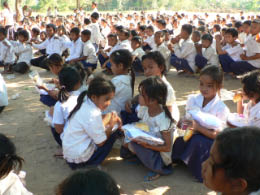
Children with their gifts |
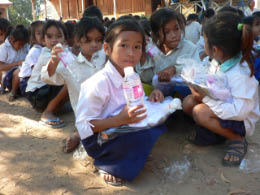
Children enjoy their snacks |
The kids dived into their sweet rolls. They were hungry and the rolls were a real treat. In no time, the celebration was over and the kids left, each carrying their gift. Then we gave the teachers each a shirt. The giving was the easy part, Man Sowun had organized and orchestrated it all and without a glitch. I know Mao and others worked very hard to make this miracle happen. (Can't say thank you enough.)
It was about noon when the last child was gone. We aksed Man Sowun if the children were coming back to their classes in the afternoon. We wanted to get some pictures of them in their classrooms. She told us that there are no classrooms and that the children meet outdoors. Then she said, with quiet "Ghandi" authority - "You make the building."
A group of village leaders, along with Man Sowun, walked us out to the open field next to the a building they call the school - but could not possibly hold all 720 students. They pointed to a marshy field they want to reclaim to build a classroom (we think-nobody spoke English to give us a complete explanation). The area needs to be pumped out at a cost of $3,500. We weren't sure what they were asking for - we'll get the details from Chanra when we get back home. But we think this will be the next project for the Cambodian Village Fund.
We walked to Mao's house -- Man Sowun refers to it as "Hotel Mao." It's a house built on stilts. The family hangs out on the ground level under the house where there is shade and some breeze. Today the ground floor was packed with family, village dignitaries, teachers and us (the most honored guests). In no time Mau and her kitchen crew served a huge Khmer feast - barbequed chicken wings (my favorite), shrimp, beef, veggies, rice with special sauces. Everything was delicious and fresh, made with the meat and veggies we picked up at the market just a few hours earlier. Man Sowun had organized and orchestrated the entire production and what an amazing job she did.
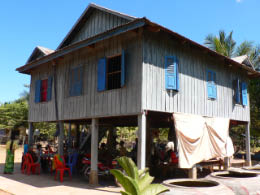
Hotel Mao |
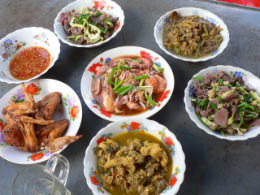
Hotel Mao's 5-star luncheon |
We stuffed ourselves - then came pastries - then, for the after lunch entertainment, a handsome young guy scurried up a palm tree to gather coconuts. We drank the coconut milk with straws. Didn't think I could hold another ounce.
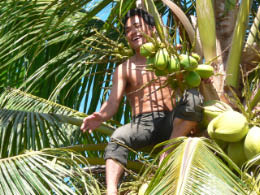
Coconuts anyone? |
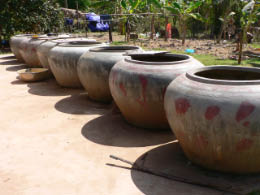
Rainbarrows outback |
I took a little stroll around the grounds. An orchard of various trees surrounded the house -- coconut trees, guava trees, and others I didn't recognize. Five or six large rain barrels at the back of the house were used to collect rain water. A beautiful young, smiling girl was chopping some kind of stalk to feed the family cow. The outdoor facilities and adjacent kitchen were separate from the house. The women (from Mao's friends and family) were sitting on the kitchen floor (rather, ground) in a circle enjoying their lunch. Everyone was smiling and happy. Only the male teachers and village leaders were eating with us. (The women teachers had to go home to feed their children.) Man Sowun was at the head of the table and in charge of the entire operation. One by one, as the teachers and village leaders began to leave, they each stopped to say a few words to Man Sowun and show their respect. It was an impressive sight. They, like me, were honored just to be her presence.
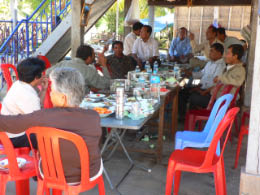 Lunch with the guys - village leaders and teachers |
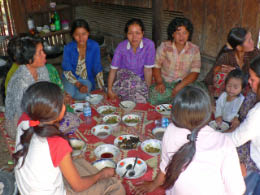
Lunch with the gals |
After the other guests left, Bill and I wanted to explore the village. Off we went with Man Sowun, Mao and assorted family members. We stopped at the local temple. Man Sowun showed us the stupa where her husband is buried. Carved at the end of a long string of Cambodian letters was "USA". Man Sowun said her name was there as well. I would love to know her story. With her wisdom and strength, I can understand how she survived the Khmer Rouge and managed to get her children to safety.
Next we headed down the dirt road Man Sowun had built years ago connecting the farms to the main road. The road had huge potholes and was badly in need of repair. I can't imagine driving a tractor during the rainy season.
An ice cream man came peddling by with his frozen goods. We stopped him to buy ice cream for the few kids nearby. Word travels fast and, within minutes, a gang of about 30 to 35 kids had gathered for their treat. It was so fun to see them running gleefully down the road, bare feet kicking up dust. They stopped at the ice cream truck (really ice cream bike) and waited for their turn. In silence, they enjoyed this simple, rare treat. The ice cream had a coconut flavor and was very tasty. Bill and I shared one. One little bare-butted toddler gobbled down his ice cream and stood quietly while the others finished. Man Sowun patted him on the head and said, "This one needs another one." In a matter of minutes, he was gobbling down another ice cream. None of the other kids complained -- "Hey, he got another one - what about me?" There was no pushing or grabbing - just little kids standing along the dirt road together with melting ice cream dripping down their happy, dusty faces. The bill for the ice cream--$10. The kids smiling faces--priceless! I only I wish I could be there every afternoon when the ice cream man cometh.
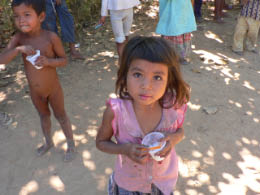
Time for ice cream |
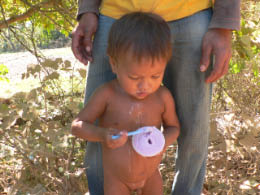
This one needs another one! |
We stopped in at a few farms to say hello. With this season's rice harvest over, we saw the big piles of rice drying in the sun. It looked like stacks of wheat. Mingling around the stacks were a few cattle and chickens pecking the hard, dry ground. Man Sowun and her group directed us down the road to one farmer's house. We went upstairs and saw him laying paralyzed on the open porch. He was probably in his 30's and suffered a major stroke a couple of years ago. His worried wife was by his side. They have ten children to feed. Life is really tough for them. We gave them a little money and left with heavy hearts.
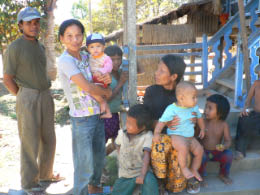
The farmer's family |
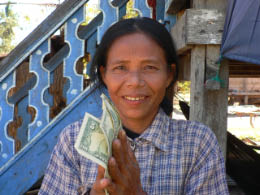
The farmer's wife thanks Buddha |
The sun was very hot, so we went back to Mao's house to relax with her family on the patio under the house. It was hang out time - Bill in the hammock, me on a mat, the family relaxing and a beautiful two-year old baby girl (Man Sowun's great granddaughter) taking her nap in a small hammock. (She defined the expression: "Sleeping like a baby".)
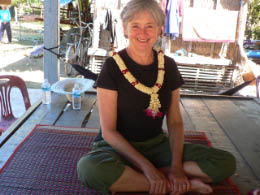
Nancy with her flower lai |
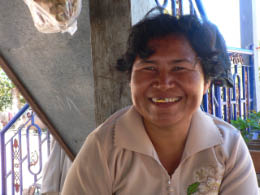
Big smile from Mao
|
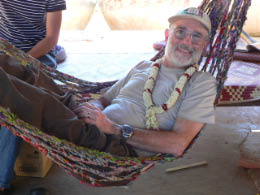
Bill relaxing in the hammock |
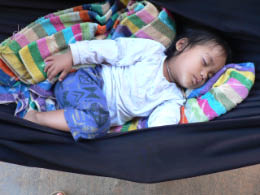
Man Sowun's great granddaughter sleeping like a baby |
Our tummies were stuffed from the huge lunch, the coconut, the ice cream, but Man Sowun brought out yet another goody to share - French bread dipped in sugar. Never had such a thing, but it really tasted good,
About 2:30 we were ready to go back to Battambang. Man Sowun said we'd stop at a big temple on the way to say a prayer of thanks to Buddha. She grabbed three bags of incense sticks and we were off -- Man Sowun, Mau and our young, handsome "James Dean" driver.
The temple was grandiose. We lit the incense sticks and offered up our thanks for so many good things that happened that day. Then we walked around the temple grounds looking at such strange statutes with Western eyes and speculated about their meaning. Not many tourists stumble in on this place. We waited with Mao while Man Sowun talked with the monks and videotaped them. I felt close to Mao. Several times I broke into English, forgetting that she didn't understand. I just felt like I had meet a new pal - and language wasn't an obstacle. Mau dashed off to the little road and found a street market to buy us a special canned drink. With her big smile, she offered us a drink labeled "Bird's Nest White Fungus." I was afraid to drink mine, but Bill tried it and said it had floaties in it - is that the bird's nest part or the fungus?
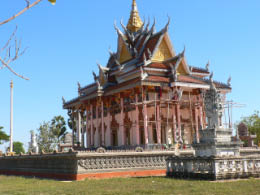
Quick stop at the temple to say our thanks |
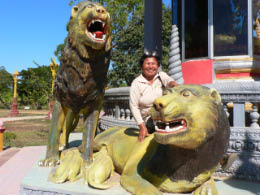
Mao posing with some lions |
On the way home, Man Sowun kept asking how I was doing and if I wanted anything to eat. I laughed and would say, "Stop it - I couldn't possibly eat another thing." Along with pulling off a major production, she was focused on our well being. She took very good care of us.
We got back to La Villa hotel and said our good-byes to Man Sowun, Mao and our handsome driver. After a shower and a little rest, we walked across the river on a make-shift rickety bridge used for the more daring townspeople to cross into old colonial Battambang. (The main bridge is gone and in the process of being replaced.) I held my breath and tried not to look down through the wobbly planks. (I can push fear aside for a few minutes.) We made it across (along with some monks and kids and young citizens) and walked into town.
We ate at the White Rose. Still full from the day, I ordered just the soup. It was a busy place crowded with backpackers and professors. It was very noisy in the café opened to the street -- motorcycles buzzed by, fans whirled overhead and the heavy wooden chairs made loud irritating noises scrapping against the hard floors. I missed the village and the country life. Man Sowun and her family were probably having leftovers in the quiet evening air in the village.
After dinner we went across the street to check out the activity at the temple. Four guys in two dragon costumes were jumping around to loud drum beats. The crowd was ecstatic - lots of little boys practicing their kung fu to the beat.
We walked through the town and along the river back to our hotel - took the long way home because we weren't up for crossing the rickety bridge in the dark. We made our way over rubble with no street lights (there were beautiful street light standards, but no light). I was afraid I'd twist my ankle or a vehicle would run me down. This poor old town has a long way to go to reclaim it's lost charm and beauty. We were happy to be back in our oasis - the hotel. La Villa has managed to reclaim it's charm and beauty.
We tried to check our email, but the system kept crashing. We learned that an Internet company planned to install a cable from Cambodia to San Francisco to join the rest of the world in fast, Internet service. However, word on the street is that a high ranking Cambodia government official demanded a million dollar bribe. The company said "No dice" leaving Cambodia in the dark ages of dial up.
Saturday, Jan. 19 - Drive to Siem Reap
We had breakfast and arranged with Mon Suwon's grandson (the James Dean clone) to pick us up to drive us back to Siem Reap. He was late, then we stopped for gas, so it was about 10 before we left (plus there was price adjusting - never a pleasant experience - especially if you can't speak the language).
The first hour, the road was OK, but the last couple of hours, the road was horrendous - dirt road, under construction and full of dust and deep potholes. The clouds of dust coated everything in site - the cattle, the houses, the trees, the cars, the people. The good news was the dust was so thick you couldn't see the oncoming traffic and the near head on collisions we narrowly averted. Traffic is pure madness here. It seems like you can do anything you want as long as you lay on your horn. Somehow it works and no one seems to get angry in this giant game of chicken. After a couple of hours, we asked the driver to make a bathroom stop (rather, we communicated through pantomimes). The road was bumpy and his bladder was much younger than ours. Bill retrieved our dusty laptop from the trunk to try to cushion it from the rest of the bumpy ride.
We finally arrived at our hotel in Siem Reap about 2 pm - dusty, tired and all shook up. We agreed that was probably the most dangerous part of our entire journey - Glad it's over.
Our hotel, Bopha Angkor, right across from the river, is lovely with its beautiful gardens and a rooms filled with antiques. (However, the giant bed took up almost half of the room. We were lost in it.) We prefer these smaller hotels - so much more character than the big, fancy, international, impersonal, grandiose places.
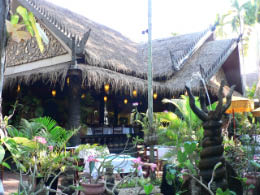
Bopha Angkor Hotel |
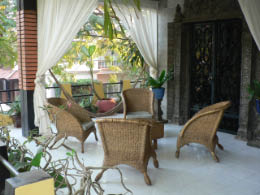
Right outside our door |
We walked into town for a beer and some lunch. We ended up back at the Khmer Kitchen. We avoided the beef and noodle dish. I had fried rice and Bill had soup. With beer, the bill came to $6.50. We walked through the Old Market, but the heat was getting to us. Bill stopped at a CD store to buy some traditional Cambodian music and then we walked back to our hotel.
We rested, showered and then took a tuk-tuk to FCC for dinner. We were happy with our Khmer dishes and coconut crème brulee. We hired a tuk-tuk (driven by "Mr. Deth") to take us back to our hotel. The ride was lovely - no problem with "Mr. Deth." We went to our room - I worked on the journal while Bill snoozed.
|











